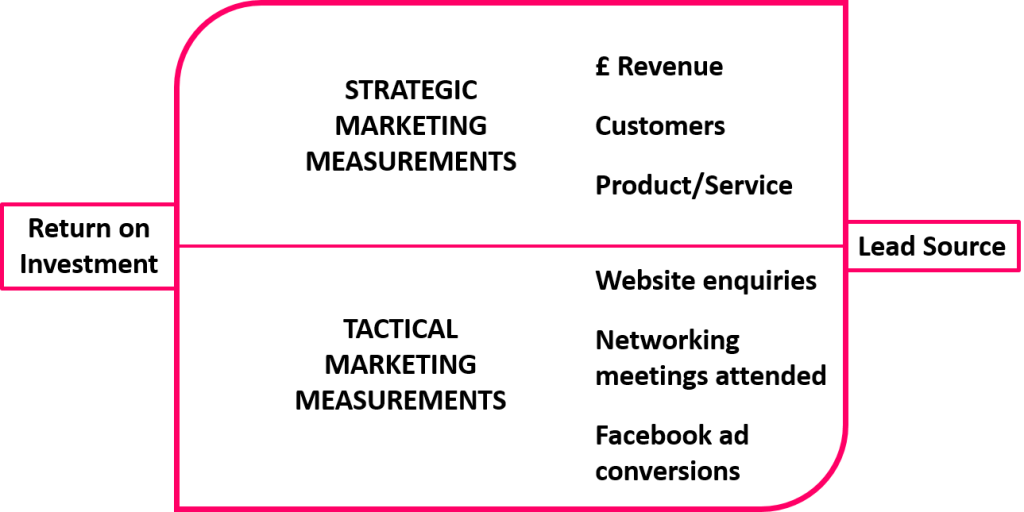Why measure your marketing?
Seems like a pretty obvious question, but I wonder how many of us actually measure the results from our marketing.
Perhaps you’ve left the corporate world to get away from the pressures of targets and endless meetings presenting figures and forecasts. Those were the days when you 
It certainly pays to keep your eye on results achieved from your marketing efforts. This will help you to make better decisions and ensure that your marketing budget is spent wisely. Time is a valuable resource too and knowing where to focus this scarce commodity, will ensure you are more productive and effective.
Marketing Measurement Rule of 3
Firstly, I’d like to introduce the Marketing Measurement Rule of 3. When you apply this rule it will help you form meaningful measurements.
- The Goal
- The Measurement – Key Performance Indicators / Metrics
- The Decision
The danger is ignoring No. 1 and No. 3 and just focusing on No. 2.
This can result in a huge waste of time and energy. The measurement is of no use if it can’t be related to a goal. If a goal isn’t set, you won’t know if the marketing activity has been successful or not. If you don’t know if it’s been a success, you can’t make any meaningful decisions as to whether to continue with the activity, stop doing it all together or tweak it to improve it.
So for each measurement set a goal, record the measurement and make a decision based on the results.
Here’s an example that I love to tell. As I was getting ready to go to an early morning breakfast networking meeting, my husband looked at me through sleepy eyes and said, “Do you have to get up so early to go to these meetings? Do they really work?” To which I was quickly able to reply “They do work. I’ve generated £10,000 through being a member of this group in the last year. That’s a good return on my investment and I am happy to renew my membership”. “Great!”, he said. “See you later!”
How are you going to measure your marketing?
The success or not of your marketing activities will generally come back to whether they’ve helped you to achieve your business goals. That is why you need to have measurements relating to your sales, customers, products and services.
In the diagram above, the top level relates to your sales and marketing strategy and the bottom level relates to your tactical marketing activities. You can see that if you didn’t measure against the strategic goals you wouldn’t be able to conclude how successful your marketing activities have been.
What might your sales and marketing goals include?:
- Total annual sales value
- Number of customers required
- Number of customers by varying types of service you offer
- Number and sales value of products by type
- Break these down again to obtain a monthly target
Obviously this will differ depending on your business. These figures are important because they will be your bench mark as to whether your marketing activities have generated the leads that are required to gain the sales targets you’ve set.
Marketing Dashboards
When I run my Marketing Planning workshop I ask the delegates to complete two spreadsheets before they arrive. The first one is my favourite! I refer to this and update it for my business every month. If you don’t already have something similar I urge you to create your own version. It will look something like this:
Eureka!
I’ve had enthusiastic feedback from workshop delegates when they’ve completed this exercise telling me they’ve had a Eureka moment! And that’s even before we’ve spend the day together!
One delegate said to me “I hadn’t realised how much revenue I’ve generated from an extra service that my clients were requesting when they first booked me!” You won’t be surprised to know that she now actively markets that extra service and proactively promotes it as an upsell.
Another said, “I hadn’t realised how much I’ve generated from a London networking event that I’ve not been back to for six months!” You guessed it! He’s made the decision to make the effort to travel to London and not to miss this particular event.
Serious decisions can be made based upon this spreadsheet, because you can see exactly how much revenue you’ve generated from which marketing activity.
Something else that is really helpful…
The same information gives you a great insight into who is your ideal customer.
You can now see who your top 10 customers are (or look at top 20%) by revenue. (remember though, whether they are your top 10 most profitable customers is another question.) By taking a look at the similarities and characteristics of your most important customers you are likely to see a pattern forming. This information will help you to work out who your ideal customer is and what problems they came to you with that you’ve now resolved.
Give them a call and ask them why they chose you! This will help you to define what differentiates you from your competitors.
All valuable intel!
Return on Marketing Investment
Here’s one more spreadsheet that I suggest you create. This enables you to measure the value generated from your marketing in relation to the cost of that marketing activity.
Decisions you might make from this could be:
- Which marketing activities should I continue/increase?
- Which marketing activities should I stop?
- Which marketing activities should I look to improve and how?
- Which marketing activities should I start?
Lead source is really important
I can’t stress enough how important it is to know where your business has come from. For some businesses this can be a real challenge. Find a way to capture where your customers heard about you. Ask the question!
Measuring your marketing activities
We’ve looked at the top level measurements, now let’s have a look at applying the marketing measurement rule of 3 to a few marketing activities. Here are some examples:
Measuring networking
Goal = Generate £10,000 in 12 months or Generate 12 customers or ROI of 300%
KPI = Attend 1 networking meeting per week, book 3 follow up meetings from each event
Decision = Whether to renew membership or not. Improve results by becoming more actively involved and making use of other benefits offered to members.
Making networking decisions
I recall a conversation when a networking colleague said “I’ve spent £1500 on networking in the last year. I think I need to cut back”. My reply was “How much has that £1500 made for you and if it has contributed significantly to your overall financial target, perhaps you need to invest more!”
I suggest a little more investigation is required before increasing the networking budget, but you get the gist.
Measuring website marketing
Goal = Generate X leads per month from website
KPI = Number of downloads of your eBook, enquiries, top performing pages
Decisions = Create a low cost, high value offer for those who download your eBook, improve top performing pages, invest in SEO or PPC
Measuring Email Marketing
Goal = 1 new client per month, 10 product sales per month
KPI = Opens, click throughs, engagement – comment, shares, replies
Decisions = Call all those who click through, create 4 case studies per year because they generate most interest, outsource your eNewsletter!
Measuring Social Media Marketing
This is a huge subject and too big to go into in this blog. However, I would urge you if you’ve not done so to take a look at Twitter analytics, Facebook insights, LinkedIn analytics and Google analytics. Just remember to ask yourself a question relating to a goal, find out what you need to look at to measure it and then what valuable decisions you can make from the information.
Measuring Marketing Success
Measuring the results of your marketing efforts doesn’t have to be too onerous. I hope these marketing measurement tips have given you food for thought and some ideas about how to begin measuring your marketing success.
If you have a question arising from this article, please email me or call on 07565 382803.







